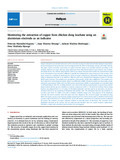| dc.description.abstract | Copper is found in several minerals in the earth's crust with varying the elemental and mineralogical composition.Several techniques of extraction have been investigated all in the effort of obtaining a cheaper and viable method.This paper reports on further works done on copper extraction using a wet chemical method. According to the method, reduction of copper (II) ions using hydra zones from chlorinated chicken waste leachate was stoichio-metrically driven. The chicken dung leachate used was an impure bio-material in which the concentration couldnot be determined. It was, therefore, difficult to quantify the stoichio metric ratios of species in that reaction. Thispaper reports on a method of monitoring the extent of copper reduction by chlorinated chicken dung leachate using an aluminum electrode as an indicator. Mineral rocks were obtained from Maragwa Location in Tharaka Nithi County in Kenya. The samples were ground into a fine powder of 250 micro millimeters. The samples were then subjected to mineralogical analysis using X-ray diffraction (XRD). Chemical analysis was done using atomic absorption spectroscopy (AAS) and X-rayfluorescence spectroscopy (XRFS). Ground samples were leached using1.0M hydrochloric acid. The resulting leachate was treated with chicken dung leachate prepared from chicken dung in which chlorine gas was bubbled at a constant temperature of 28 C. The pH of the resultant chicken dung leachate was adjusted from 4 to 12 using 1.0 M sodium hydroxide and then used as an electrolyte. An electro-chemical cell was set up consisting of aluminum and graphite rods. The aluminum electrode was found not to corrode at pH above 11 while it was able to displace available copper ions. This property of the aluminum electrode was used to monitor when all copper ions were displaced. The recovered copper was analyzed using XRFS. The copper recovery rate from the samples ranged from 7.0 to 20.0 at level A and 7.4–26.8% at level B with a purity range of 84.9 level A to 88.6% level B. An overall positive potential in the reduction process confirmed the greater the tendency of copper reduction without an external source of electricity. The corrosion of the aluminium electrode in the process was not observed and therefore does not require frequent replacement.Therefore, a large scale extraction process needs to be investigated | en_US |

